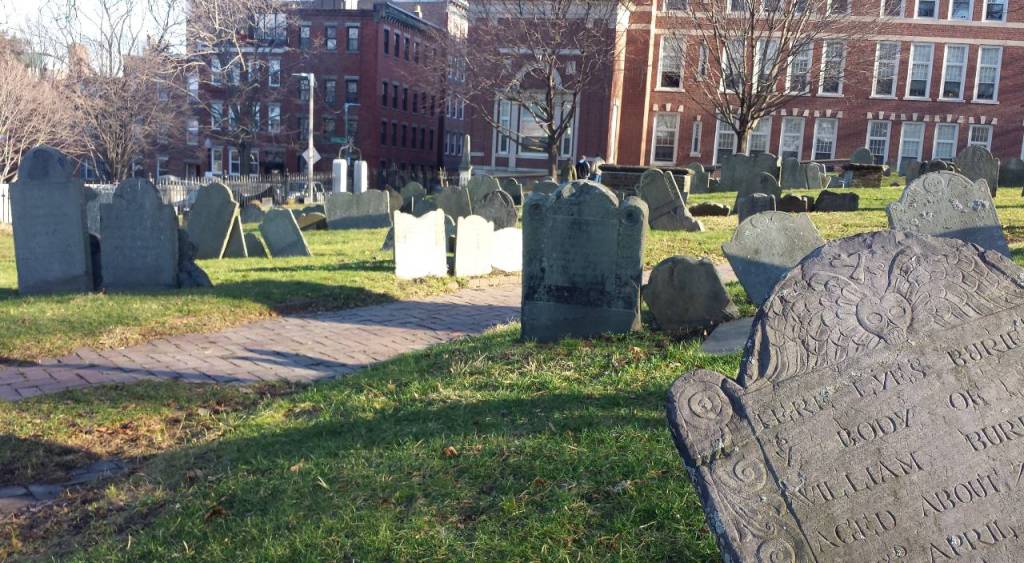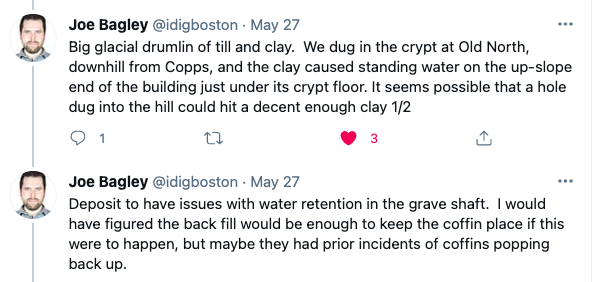
If you’ve been a reader for the last year or two, you’ll know that I’m currently working on my PhD in historical archaeology at Memorial University of Newfoundland & Labrador! My research is looking at the development of the 17th-century burial landscape in northeast North America, and through the centuries in the outport community of New Perlican, NL. Part of this research involves combing through accounts from the 17th century for details on death, burial, and funeral practices at the time. This information gives us a better idea of how the burial grounds were being used, what people thought of them, and how they changed through the decades and centuries.
Now, I’m only 9 months into my program and have just finished my coursework a few weeks ago, so I don’t have too much of my own research finished yet, but other than lining up some fieldwork and preparing for my comprehensive exams this fall (eep!), I’ve been cataloguing mentions of burials and funerals in the diary of Samual Sewall. Judge Sewall, a public figure and later known for his involvement in the Salem witch trials of May, 1893 (for which he later publicly apologised, so that’s nice), kept a diary of his life fairly regularly from 1674 – 1729, one year before his death. Many Puritans kept detailed diaries and Sewall is no exception. Due to his importance in the community as an educated judge and printer, he was very aware of the community and recorded deaths beyond his own family.
Black & Indigenous Burials
One of the things I was really interested in to see in these 17th-century records is if there was any accounts of BIPOC individuals being buried in settler burial grounds. This is one of the questions I’m hoping to look into with my research. Settler communities are portrayed at white, mostly male, places in the 17th century, but of course this wasn’t the case at all. These communities, built on Indigenous lands were, populated by people of all genders, ancestries, and skin colours, but what we read about these spaces does not reflect this. I’m hoping to look into if minority groups were represented in settler burial spaces, or if they are visible in the records from this period with regards to burials. Going through the Sewall diary was the first step of my research, and I’d like to discuss some of the interesting entries that I have been cataloguing.
There is always the chance that I missed some mentions of funerals or burials, but I hope I got the majority of them! I went through the diary and flagged three categories of burial. Yellow tabs for the mention of a burial but no description, green tabs for a burial and funeral with some details included, and pink for BIPOC death and burial mentioned at all. In total, I recorded 127 burials that Sewall mentioned from 1674 – 1699 (we are, of course, missing May 1693 because he was off being involved in the witch trials and didn’t write much on the topic), and only six mentions of individual Black and Indigenous peoples’ deaths, with only one mention of a burial. This doesn’t include Indigenous peoples killed in fights or battles, of which there were many. 64 burials records did not have descriptions of the funeral or burial process, 56 had some description of the burial and/or funeral.
The following account is a description of the death of an Indigenous individual, as the result of settler colonialism. All capitalisations and spellings are from the original text.
- October 5-6, 1688: “Mis. Angler of Cambridge is buried…About 9. night, Thomas, an Indian and very usefull Servant to Mr. Oliver, hang’d himself in the Brewhouse. The Coroner sat on him, having a Jury, and ordered his burial by the highway with a stake through his grave.” (Sewall 1973:179)
This is the only account out of the six that mentions how the individual was buried, or that they were buried at all. All other mentions of burials that I noted were for individuals who did not have their ethnicity recorded, likely settlers. The other five BIPOC individual deaths recorded did not note their burials, and four people did not even have their names mentioned. The man mentioned in the account above, called Thomas, died by suicide and the coroner ordered his burial to take place on the side of a highway with a stake in his grave.
While it was often considered that suicide deaths could not be buried in consecrated ground, it appeared that the stake was added measure in Massachusetts in the 17th century. “Thus, in 1660 in Massachusetts, the Colonial legislature considered suicide to be ‘wicked & unnatural’ and thus enacted a law that every suicide victim “shall be denied the privilege of being buried in the common burying place of Christians, but shall be buried in some common highway…and a cartload of stones laid upon the grave, as a brand of infamy, and as a warning to others to beware of the like damnable practices” (Historical Society of Pennsylvania 2009).
Or course, this rule was not upheld for everyone. Earlier that same year, Sewall wrote: “Samuel Marion’s wide hangs herself in the Chamber, fastening a Cord to the Rafter-Joice. Two or three swore she was distracted, and had been for some time, and so she was buried in the burying place” April 4, 1688 (Sewall 1973:163). While I’m sure it was a comfort to Mrs. Marion’s family that she was able to be buried in the burying place (there was no consecrated ground in C17th Puritan Boston), it is clear that preferential treatment took place in the manner and location of the burial of these two individuals.

Puritan Funeral Accounts
There were a number of other notable burials that really stood out to me, for their descriptions of the Puritan funeral and burial process. Unsurprisingly, Sewall described the burials of people who were close to him or were prominent members of the community, but the majority of the burials recorded did not have any description at all beyond ‘buried’. This isn’t a surprise either, since the old adage is ‘the Puritan dead were buried in silence’ after all! Here are some of the more intriguing entries:
- December 24, 1685: We follow little Henry [Sewall] to his Grave: Governour and Magistrates of the County here, 8 in all, beside myself, Eight Ministers, and several persons of note. Midwife Weeden and Nurse Hill carried the corps by turns, and so by Men in its Chestnut coffin ’twas set into.a grave (The Tomb full of water) between 4 and 5. At Lecture the 21. Psalm was sung from 8th to the end. (pg. 89-90)
- November 29, 1686: Mr. Whetcomb is buried. Coffin was lin’d with Cloth on the outside and below the name and year a St. Andrews cross made, with what intent I can’t tell. (lists bearers). Gave scarvs… Should have been buried on Friday, but the storm of rain hindred. (pg. 126)
- November 8, 1688: Capt. Thomas Smith dies about 5. mane; buried Nov 10. Benj. Brown led the widow, buried in the old burying-place. The Lord grant I may be ready when my turn shall come to be becken’d away. (pg. 183)
- September 23, 1690: [Judith Sewall died Sabbath, Sept 21, 1690]. Tuesday between 5 and 6 Sir Moodey carriesthe Body of my dear Judith to the Tomb, Solomon Rainsford receives it on the Stairs and sets it in. On the Coffin is the year 1690, made with little nails. (pg. 267)
- April 6, 1694: Major Richards Is buried in his tomb in the North Burying Place; Companyes in Arms attending the Funeral. [Lists bearers]. Coffin was covered with Cloth. In the Tomb were fain in nail a Board across the Coffins and then a board standing right up from that, bearing against the top of the Tomb, to present their floating up and down; sawing and fitting this board made some inconvenient Tarriance. (pg. 318)

You’ll notice in the first and last entry noted above, water inside the burial shafts and tombs is mentioned. For the burial of Major Richards, Sewall mentions that the burial was at the North Burying Ground, known today as Copp’s Hill. I was confused by the mention of coffins potentially floating up and moving around on a site that is famously on a large hill within the city of Boston, so I reached out to colleagues on twitter (as one does).
Joe informed me (and twitter) that the geology of Copp’s Hill is a glacial drumlin of till and clay, which creates very poor drainage in the area. Even though the burial ground is located on a hill, the poor drainage means that if there is a lot of rain, it could pool inside the grave shaft and family vaults and stay there for quite some time, resulting in floating coffins! Joe even said that they had standing water in the crypt area at Boston’s Old North Church as a result of the clay below. It was amazing to me that they had to come up with wood braces and other contraptions just to ensure their loved ones stayed underground, probably not a problem the C17th inhabitants of the city expected when the picked the former farm and windmill site for the burial ground!
I could go on and on about the interesting accounts in Sewall’s diary entries, but I think I will leave you with those preliminary observations for today! I am looking forward to investigating the burial practices of the C17th settlers and seeing the how Black and Indigenous individuals were given space, if any, to be included in those same burial spaces. And of course, I’ll be sharing my research journey along the way on here! Fieldwork is beginning in a couple of weeks, and I’m going on a site visit soon, so expect photos. As always, thank you for reading!
References:
Historical Society of Pennsylvania. 2009. With a Stake in the Heart: Suicides or ‘Self-Murder’ and a Peculiar Custom. Historical Society of Pennsylvania. Website: https://hsp.org/blogs/hidden-histories/with-a-stake-in-the-heart-suicides-or-self-murder-and-a-peculiar-custom
Sewall, Samuel. 1973. The Diary of Samuel Sewall: Volume 1, 1674-1729. Edited by M. Halsey Thomas. Farrar, Straus and Giroux: New York.

June 1, 2021 at 4:30 pm
Absolutely fascinating!
LikeLike
June 1, 2021 at 4:33 pm
Thanks so much!
LikeLike
June 1, 2021 at 6:58 pm
Very interesting! (Particularly for me as my SO is descended from Samuel Sewall — which is not unusual if you have any roots in colonial New England, I think— and we occasionally wander through Copp’s Hill.)
LikeLiked by 1 person
June 1, 2021 at 8:13 pm
Thanks so much for reading! That is really cool!
LikeLike
June 7, 2021 at 4:49 pm
Fascinating, indeed! I’m sure you’ve read this paper about Judge Sewall’s diary by my friend Laurel K. Gabel, from the AGS’s annual journal “Markers” No. 25.
https://credo.library.umass.edu/view/pageturn/murb004-01-i025/#page/17/mode/1up
LikeLike
June 7, 2021 at 4:51 pm
I actually hadn’t, thank you!!
LikeLike
Pingback: The Comprehensive Exams of a PhD Student during a Global Pandemic | Spade & the Grave
Pingback: Cataloguing Funerals & Burials in Joshua Hempstead’s 18th-Century Diary | Spade & the Grave
Pingback: SHA 2023 Conference, Lisbon, Portugal | Spade & the Grave